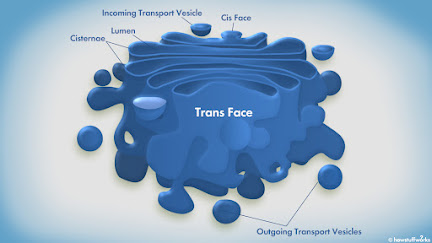Golgi Apparatus

Golgi Complex / Golgi Apparatus Golgi apparatus is found in all types of eukaryotic cells except the mammalian RBCs. It is absent in prokaryotes. Golgi apparatus are small sacs which are responsible for transporting, modifying and packaging proteins and lipids. The golgi apparatus was discovered by Camillo Golgi in 1898. He discovered them in the nerve cells. Golgi apparatus has a system of outer flattened cisternae which appears as parallel membranes in the form of an ellipse. There are two faces known as cis and trans face of golgi apparatus. The cis face lies near the rough endoplasmic reticulum and the trans face lies near to the cell membrane. Substances from the rough endoplasmic reticulum enter through the cis face for processing and they exit from the trans face in the form of smaller vesicles. Functions: Packaging center of cell. Proteins are processed and sorted for their transport. Lipid processing. Secretory proteins like hormones are packed into secretory vesic...






